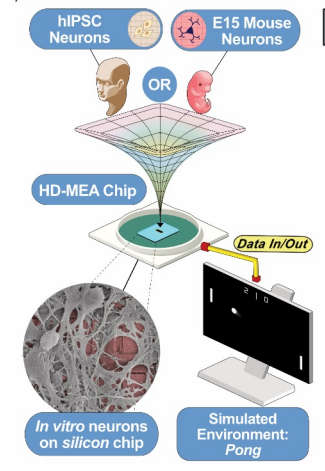| Brain In A Dish Learns To Play Pong |
| Written by Mike James |
| Wednesday, 12 January 2022 |
|
... and it learns faster than an artificial neural network. It is arguable that none of the approaches we take to general AI will ever lead to general AI. The reason is that we understand them too well. We might need some wet stuff to make it all work. It has long been a theme in science fiction that intelligent robots would contain some element that made their operation opaque to the experts who created them. For example, Asimov thought up the positronic brain that gave robots a limited but effective AI. The positronic brain was supposed to be so advanced that its exact functioning wasn't well understood and it needed skilled interpreters, something like psychiatrists for the human brain. You can appreciate that this is a good literary device that like his laws of robotics makes for good story telling but there is a very real idea here. If we have any deterministic and well-understood mechanism then we cannot possibly regard it as intelligent - it's just a machine.
So news that cells in a petri dish can play pong is perhaps more important than it first seems. A group of scientists connected a group of live neurons up to a game of pong and gave the paper reporting the results the headline-grabbing title: In vitro neurons learn and exhibit sentience when embodied in a simulated game-world. I'm not sure "sentience" is a word that should be used quite so casually, but the results are interesting nevertheless. We developed DishBrain, a system which exhibits natural intelligence by harnessing the inherent adaptive computation of neurons in a structured environment. In vitro neural networks from human or rodent origins, are integrated with in silico computing via high-density multielectrode array. Through electrophysiological stimulation and recording, cultures were embedded in a simulated game-world, mimicking the arcade game ‘Pong’. "DishBrain" - not sure that one will catch on as the label for a sophisticated and glamorous breakthrough technology, but at least it is descriptive. "Neurons can be grown or harvested in numerous ways. Cortical cells from the dissected cortices of rodent embryos can be grown on MEA in nutrient rich medium and maintained for months. These cultures will develop complicated morphology, with numerous dendritic and axonal connections, leading to functional BNN (Biological Neural Networks)" OK, so now you have a brain in a dish complete with connections - the details are far more complicated but this is the rough idea. The next step is to provide inputs to a selected "sensory area" from a simulated game of Pong. The BNN was given a coded input relating to the position of the ball and could control the position of the bat. Feedback was provided as a stimulus when the BNN got it right: This video is an edited version of the actual BNN in action and it gives you the general idea of how things work. There are lots of doubtful descriptions and claims in the paper. For example, the BNN learns faster than an artificial neural network (ANN) is a claim that isn't actually tested, but seems very reasonable. The BNN learns in a very small number of presentations, but then what is being learned isn't as much as a ANN acquires in thousands of repeats. There is also a lot of discussion of "embodied in a simulated world" and so on .. all speculative and mostly hype that does the cause little good. Notice that this research is being done in conjunction with a commercial company, Cortical Labs, which plans to sell chips based on this technology. In fact, as much as proving that BNNs can do things, growing the BNN on a matrix of connections and getting it to do anything even vaguely useful is a big step towards the unknown. Could it be that this is the start of the "positronic" brain of some sort? As the paper concludes: "Ultimately, although substantial hardware, software, and wetware engineering is obviously still required to improve the DishBrain system, this work does evince the computational power of living neurons to learn adaptively in active exchange with their sensorium. This represents the largest step to date of achieving synthetic sentience capable of true generalised intelligence."
More InformationIn vitro neurons learn and exhibit sentience when embodied in a simulated game-world Related ArticlesNeurons Are Smarter Than We Thought Too Good To Miss: Neurons Are Two-Layer Networks Google Has A Network More Like The Brain Neuromorphic Supercomputer Up and Running Deep Learning from the Foundations China's Tianjic Chip Rides A Bike Neuromorphic Supercomputer Up and Running IBM's TrueNorth Simulates 530 Billion Neurons Flying Neural Net Avoids Obstacles The Paradox of Artificial Intelligence To be informed about new articles on I Programmer, sign up for our weekly newsletter, subscribe to the RSS feed and follow us on Twitter, Facebook or Linkedin.
Comments
or email your comment to: comments@i-programmer.info
|
| Last Updated ( Friday, 14 January 2022 ) |


